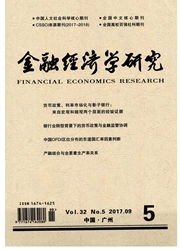

 中文摘要:
中文摘要:
金融不平衡问题促使货币政策由单一的"通货膨胀目标制"向包括资产价格在内的广义价格目标制转变。基于金融加速器的视角,资产价格波动是引发金融不平衡的关键因素,货币政策调控需要研究资产价格波动及其先行指标。实证分析表明,信贷和经常账户收支等占GDP的比例,既可以作为反映资产价格波动的单项先行指标,也可以作为资产价格波动综合先行指标构造的基础。另外,货币供应量及其结构对资产价格波动也有一定影响。因此,货币政策既要关注广义价格目标函数,又要关注资产价格波动的先行指标,特别要关注房地产价格的波动和经济基本面的变化,同时,货币政策以广义价格作为调控目标时要更加注重监控流动性,要避免流动性过度地流向资产市场或虚拟经济。
 英文摘要:
英文摘要:
The financial imbalance has trigged a transformation of monetary policy from the regime of inflation targeting to generalized price targeting frame which includes asset price. From the perspective of financial accelerator,this paper believes that the fluctuation of asset price is the core factor to induce financial imbalance and there is a vital necessity for the monetary policy to analyze the leading indicators of asset price. The empirical analysis shows that the proportion of credit and current account balance in GDP can both be the leading indicator of asset prices and the basis of comprehensive indicators of asset prices. Besides,money supply and its structure also have impact on asset prices. Therefore,monetary policy should pay more attention to both generalized price and leading indicators of asset price,particularly the fluctuation of housing market and the change of basic economic factors. In addition,monetary policy should attach more importance to the liquidity of market in order to control generalized price,and it should also take precautions against liquidity excessively flowing to asset markets and virtual economy.
 同期刊论文项目
同期刊论文项目
 同项目期刊论文
同项目期刊论文
 期刊信息
期刊信息
